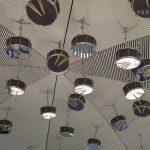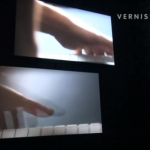“Sublime Hardware” is the title of an exhibition that Luxembourg & Dayan in collaboration with Francesco Bonami present in London. The show explores the connections between two key Post-war artworks that were made on opposite sites of the Atlantic: Dan Flavin’s “Monument for V. Tatlin” (1967) and Pino Pascali’s “Cannone Semovente” (1965). Works by Anri Sala and John Frederick Kensett complement the show.
Dan Flavin & Pino Pascali at Luxembourg & Dayan, London. Opening, October 2, 2018.
> Right-click (Mac: ctrl-click) this link to download Quicktime video file.
Press text:
Luxembourg & Dayan in collaboration with Francesco Bonami presents Sublime Hardware, an exhibition that explores the connections between two key Post-war artworks made on opposite sides of the Atlantic: Dan Flavin’s “Monument” for V. Tatlin (1967) and Pino Pascali’s Cannone Semovente (1965). The legacies of Flavin (1933 – 1996) and Pascali (1935 – 1968) draw on very different art historical traditions, contexts and materials, and on the surface of things the works appear poles apart: one a vision of light and the other of destruction. Yet the American and the Italian artists both shared a particular sensibility towards the relationship between common, everyday materials and their unconventional expressions of sublimity.
As a young artist operating in New York City in the early 1960s, Flavin was preoccupied with an aspiration to reconcile his personal interest in the effects of light as a symbolic and meaningful expression of spiritual life with the context of the modern reality in which he was operating. Flavin thus set out to redefine the importance of light as a marker of spiritual experience, poetics and the sublime – a quest that he inherited from the nineteenth century Luminist tradition as much as from recent American modernist practitioners such as the Abstract Expressionists. Using simple industrial florescent light fixtures that form minimal compositions Flavin thus proposed to rethink a whole range of sculptural and painterly ideals under new material and ideological conditions, and to formulate a new poetic order from everyday hardware.
Around the same period, in Rome, Pino Pascali was developing an equally unusual sculptural practice, where humour and irony were to become instrumental to the study of the Post-war reality in Europe. Pascali’s installations and sculptures were invested in the notion of ‘play’, which he considered an essential attribute to any form of art-making. Perhaps his best-known cycle of sculptures at the time was the Armi (weapons) — an arsenal of hyperrealist, life-size artillery weapons made of wood and cardboard scraps. Humorous as these sculptures appeared when presented in the gallery space, they also proclaimed a profound iconoclastic gesture and a serious allegation against Europe and the ideological power games that characterised world politics at the time. Pascali contemplated the nature of war, the pragmatics of weaponry, and boldly compared these to the politics of representation in art, fiction, and children’s games.
Taking Dan Flavin’s “Monument” for V. Tatlin and Pino Pascali’s Cannone Semovente as its two corner stones, the exhibition Sublime Hardware considers how these two radical artists pushed the Duchampian notion of the Object Trouvé (found object) into a new realm, namely that of the Monument Trouvé (found monument). While Duchamp was aspiring to remain nonsensical to a large degree in his appropriations of found objects, Flavin and Pascali aspired to re-establish meaningfulness and symbolism in their appropriation work. Thus, Flavin’s fluorescent sculptures do not abandon the questions of Luminist paintings, nor the quest for sublime expression in art, and Pascali’s cannons are first and foremost representational sculptures even though they are disguised as oversized toys or war machines.
In unpacking the relationship between Pascali and Flavin, Sublime Hardware expands the historical scope of the comparison with two additional artists: John Frederick Kensett (1816 –1872) — one of Flavin’s favourite Luminist artists — and the contemporary moving image artist Anri Sala (b. 1974). Facing each other in stark opposition, Kensett’s sunrise painting is presented alongside a short video titled Natural Mystic (Tomahawk #2) from 2002 – an intimate portrait of a person mimicking the noise of an artillery bomb from the moment of its launch to its final explosion. In a similar way to Flavin’s response to Kensett’s Luminism, Sala extends Pascali’s meditations on the relationship between war and play, make-believe and concrete reality, engaging with the memory of war in a fictional way.
Sublime Hardware is a provocative proposal to consider Flavin and Pascali as emblems of a wider political, technological and material set of conditions that encouraged Post-war art practitioners to avoid the pit of artificiality in their work by employing its very own mechanisms. This rare opportunity to review such important historical works in parallel and in opposition to one another, as monuments, as weapons, and as material manifestos of their time, offers a range of insights into the divide and similarities that characterise Post-war American and European art — equally cynical and romantic, detached and spiritual, but profoundly different in their effect.
“The conceptual and material simplicity that lies at the core of these monumental works –
a memorial sculpture composed of nothing more than fluorescent light tubes and a life-size war cannon made of wood scraps – is what makes them so extra-ordinary, literally speaking.” Francesco Bonami













